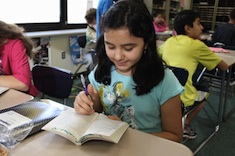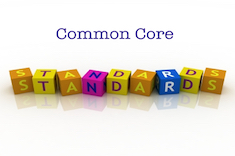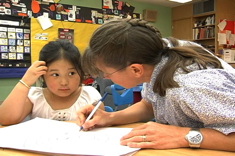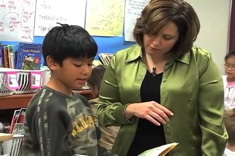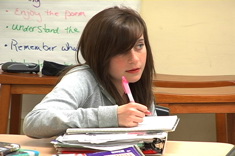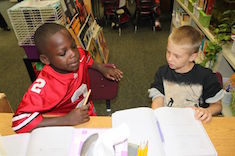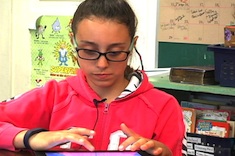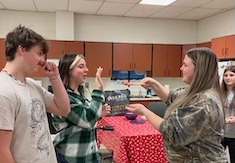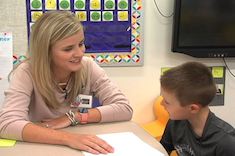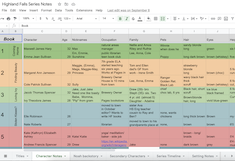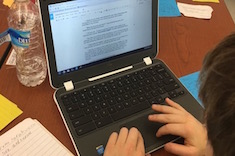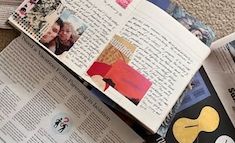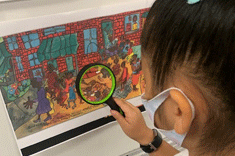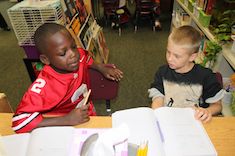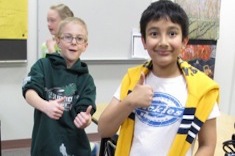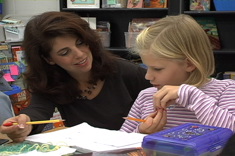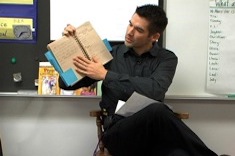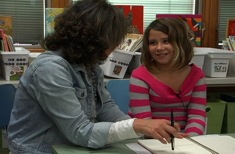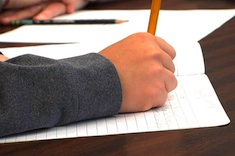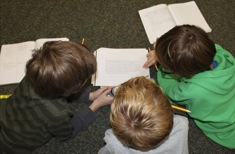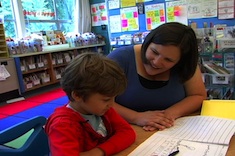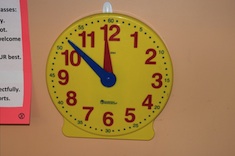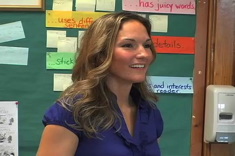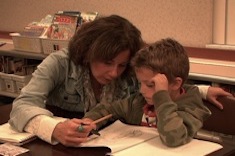Teaching Writing
Everyone who writes for Choice Literacy loves teaching writing, because we all write ourselves. We know it is "hard fun," as Donald Murray famously said—exasperating and exhilarating at the same time. The writing workshops you will read about here and see in our videos are busy, noisy, vibrant places. And most days, we wouldn't want to be anywhere else than in the midst of 'em! Here is where you'll find our latest discoveries, insights, and occasional boneheaded mistakes in teaching writing.
Latest Content
Mentor Texts and Teacher Modeling: The Listing Strategy
In this video from her fourth-grade classroom, Aimee Buckner teaches the “listing” strategy, using the book This Is the Tree: A Story of the Baobab as a mentor text. Aimee talks about mentor texts, using her own writing as a model, and the needs of intermediate readers and writers during the lesson and interview.
Common Core Conversations: Increasing Argumentative Writing
Teachers continue to puzzle over and sort through the terminology in the Common Core related to opinion and persuasive writing. Amanda Adrian and Heather Rader consider terms and teaching strategies.
The Difference Between Conferring and “Touching Base”
Debbie Miller goes against the grain, advocating for “the luscious feeling of endless time” as we slow down to confer with children.
Whole Class Interviews: Building Community in Writing Workshop (TEMPLATE)
Interviews early in the year are a potent tool for building a class community.
Important Book, Important Notes: Guiding Young Students Through Notetaking
Suzy Kaback catches a young learner near and dear to her in the process of plagiarizing. She uses the experience to develop a template to help students and colleagues with notetaking.
Breathing New Life into the Writer’s Notebook
Tara Smith finds her sixth graders have years of experience with writer's notebooks by the time they reach her classroom. How to inspire enthusiasm for a familiar tool? Mix old favorite tasks and lessons with fresh texts and tech-savvy options.
Building Community Around Food and Poetry
Gretchen Schroeder creates strong connections with her high school students as they come together as writers around the shared need for and love of food.
Conferring in Kindergarten: Drawing to Learn
Hayley Whitaker confers with a kindergartner and helps him make meaning through drawings.
Gratitude Week
Gigi McAllister shares the tradition of Gratitude Week. It gives students an authentic writing experience that has a ripple effect of spreading joy and gratitude throughout the school. It also shows them the significant impact that their words can have on others.
The Hermit Crab Essay: Finding a Shell to Share a Vulnerable Story
Gretchen Schroeder introduced the hermit crab essay as a creative nonfiction genre to her high school students. What began as an intriguing writing invitation led to realizing that students want to process these events through writing and that the hermit crab essay gives them a way to do so that is less daunting than just a blank page.
Using Fiction Writing to Change Attitudes About Writing
Katherine Sokolowski encourages teachers to take time for students to individualize the writing process and enjoy fiction writing by engaging in National Novel Writing Month. Download the story bible as a place for students to plan their stories.
Managing Independent Projects (SHORTS)
Tara Barnett and Kate Mills continue their series on independent projects with nuts and bolts advice on management.
Jose the Late Bloomer
Stella Villalba has practical advice for reaching a young English language learner who is reluctant to write and often frustrated.
Writing as an Act of Resistance and a Source of Strength
In this beautiful personal essay, Stella Villalba reminds us that writing is a source of strength, and developing a community of writers is essential in post-pandemic classrooms.
Trusting the Letting-Go Moments
Mandy Robek writes a powerful essay about giving her students more decision-making power in sharing their learning. In the release of letting go, she found ease in the joy of learning.
Talking Through Characters
Melanie Meehan shares activities that help students talk about their characters before writing about them in a realistic fiction unit.
Lifting the Quality of Peer Response
Tony Keefer discovers that his fourth-grade students need focused instruction and support to strengthen their peer conferring skills. Tony shares tips and two video examples from his classroom.
Writing Partner Feedback in Fifth Grade
Fifth-grade writers in Franki Sibberson’s classroom encourage each other and suggest revisions to their opinion-writing drafts in partner teams.
Writer’s Workshop: Planning for “Dips”
We love seeing growth, but how can we plan for plateaus or even dips with young writers? Aimee Buckner finds it's all about commitment.
Finding Topics in Writer’s Notebooks Minilesson
Sean Moore shares the importance of using a writer’s notebook to discover topics in this minilesson with his second-grade students from early in the year.
Collecting Ideas in the Writer’s Notebook
Ruth Ayres confers with third grader Jade about the importance of the “collecting” phase for writers.
Conferring with Spencer: Writing Notebook Topics
Katherine Sokolowski helps fifth grader Spencer brainstorm topics for his writing notebook.
First-Grade Writing Conference: Celebrations to Suggestions
Katrina Edwards begins her conference with first grader Allen by celebrating all he is doing well in his writing. She highlights his language and details in writing, before moving on to new strategies to try.
Giving Writers What They Need
Tara Barnett and Kate Mills are inspired by their own writing retreat experience to give students exactly what they need to thrive as writers. Take their advice to help writers thrive in your classroom, too.
Avoiding Implementation Through Lamination
Jennifer Schwanke questions the routines of how wall displays are used in classrooms.
Maximizing Instructional Time at the Start of a New Unit
Time is precious in classrooms, so Melanie Meehan shares strategies to ensure it isn't wasted at the start of new writing units by teaching skills students may already possess.
Writing Workshop Teacherisms
Jennifer Jones reflects upon the “teacherisms” in writing workshops — the language we use that defines our values and routines.
Test: Weekly Poetry Response
Ruth Ayres cautions us to not let our pet peeves get in the way when working with student writers.
Browse Content By
Type
Category
- Assessment Tools
- Big Fresh Archives
- Booklists
- Choice Numeracy
- Classroom Design
- Common Core
- Community Building
- Conferring
- Content Literacy
- Digital Literacy
- English Language Learners
- Equity
- Family Relations
- Free Samples
- Guiding Groups
- Leadership
- Literacy Coaches
- Mentor Texts
- Minilessons
- New Teacher Mentors
- Podcasts
- Poetry
- Quote Collections
- Reading Strategies
- Self Care
- Struggling and Striving Learners
- Talking and Listening
- Teacher Study Groups
- Teaching Reading
- Teaching Writing
- Word Study and Vocabulary
Author
- Melissa Quimby
- Nawal Qarooni
- Gwen Blumberg
- Julie Cox
- The Lead Learners
- Hannah Tills
- Josie Stewart
- Ruth Metcalfe
- Mallory Messenger
- Becca Burk
- Jodie Bailey
- Vivian Chen
- Mary Brower
- Tiffany Abbott Fuller
- Stephanie Affinito
- Ruth Ayres
- Leigh Anne Eck
- Heather Fisher
- Shari Frost
- Julie Johnson
- Suzy Kaback
- Gigi McAllister
- Shirl McPhillips
- Melanie Meehan
- Cathy Mere
- Debbie Miller
- Tara Barnett and Kate Mills
- Tammy Mulligan
- Dana Murphy
- Bitsy Parks
- David Pittman
- Brenda Power
- Heather Rader
- Matt Renwick
- Mandy Robek
- Christy Rush-Levine
- Gretchen Schroeder
- Jen Schwanke
- Brian Sepe
- Katherine Sokolowski
- Stella Villalba
- Jennifer Vincent
Grade Level
Choice Literacy Membership
Articles
Get full access to all Choice Literacy article content
Videos
Get full access to all Choice Literacy video content
Courses
Access Choice Literacy course curriculum and training

